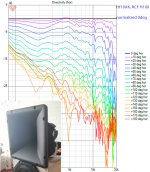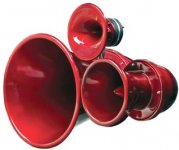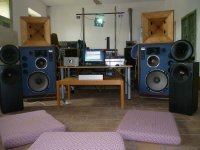Diffraction looks like that, dip on-axis and off-axis ridge. Anyway, no mouth roundover seems to do this. Here is RCF H100 showing similar response. Asked a friend to print the petal version of 260, not here yet
Idk, if the waveguide shows considerable waistbanding between 1.3k and 2.7k, maybe. But what I see is ups and downs in the HF, the cause being lower, presumably already at 1.3k (26 cm wavelength). The diffraction causes more energy on-axis over 1.3k and this is why normalized looks as if the wg is waistbanding. From 5k on you can clearly see the pattern rip through the frequency band. Let’s see what it will do baffled. Yes, free standing does not have this problem, sure.
From 5k on you can clearly see the pattern rip through the frequency band.
G'day sheeple, would you be good enough to explain what you mean be this and how to read this from the graphs please?
Cheers.
There will be all kinds of problems if the device is not properly terminated, which of course it isn't in this case (besides the fact it has a hole in it). Placing it in a box should improve the things a long way and I'm only curious how much, compared to the free standing version, as an actual comparison hasn't been done so far. It will be interesting to see.
... and how to read this from the graphs please?
I see this:
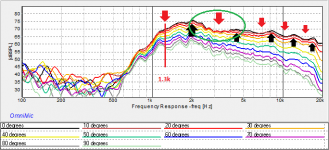
26 cm diameter equals 1.3 kHz, this is where diffraction occurs naturally (edge of the waveguide). First dip is not too obvious because of the energy overhang of the waveguide there. But then follows the usual bump, stronger on-axis, when 0-axis is normalized it looks like waistbanding, and the pattern continues.
Marcel simulated the free standing ST260 baffled-device performance: Diffraction
You will see the behaviour. Also compare to infinite baffle: No diffreaction
Your data kind of aligns to this, doesn't it.
Thank you very much for that clear and informative explanation sheeple. Much appreciated. I learnt something new just now - its a good day when I learn something new!
I was very impressed with the measured performance of the ST260/B so I'm definitely going to get it into an enclosure - at some point - so many wave guides, too little time (esp as a single father of 3).
I was very impressed with the measured performance of the ST260/B so I'm definitely going to get it into an enclosure - at some point - so many wave guides, too little time (esp as a single father of 3).
You are welcome, bet the kids love the waveguides  Consider reasonable round over for the final cabinet. A cheap 1-1/2 inch (about 4 cm) radius router bit can be bought from Yonico, or use chamfered edges of comparable dimension. I am very interested to see the baffled response.
Consider reasonable round over for the final cabinet. A cheap 1-1/2 inch (about 4 cm) radius router bit can be bought from Yonico, or use chamfered edges of comparable dimension. I am very interested to see the baffled response.
Thank you very much for that clear and informative explanation sheeple. Much appreciated. I learnt something new just now - its a good day when I learn something new!
I was very impressed with the measured performance of the ST260/B so I'm definitely going to get it into an enclosure - at some point - so many wave guides, too little time (esp as a single father of 3).
What woofer are you planning to use with the ST260?
I've read the recommended size is a 12".
Any chance one could use a 8" and still have a good match between the woofer and the waveguide at the crossover point?
Cheers
Yeah, diffraction is a headache problem.
Of course, I know the rolling back helps a lot, but I personally genuinely hate the way (sticking out) it looks.
(it's purely on my taste or even close to phobia, it's all my fault, so please not take offensive but it looks for me, lickey mouth?)
I managed to get maybe, just maybe an acceptable level of wiggling with a waveguided direct radiator (dome tweeter) and a rather conventional-looking chamfered/rounded baffle, but still jealous about the cleanness of the directivity with the rolling back and having a bit of grudge against my phobia.
Of course, I know the rolling back helps a lot, but I personally genuinely hate the way (sticking out) it looks.
(it's purely on my taste or even close to phobia, it's all my fault, so please not take offensive but it looks for me, lickey mouth?)
I managed to get maybe, just maybe an acceptable level of wiggling with a waveguided direct radiator (dome tweeter) and a rather conventional-looking chamfered/rounded baffle, but still jealous about the cleanness of the directivity with the rolling back and having a bit of grudge against my phobia.
Hi Noviceman -
I have to agree, I've always thought (until Ath4) the large free standing horn systems were more for looks rather than performance and was put off by that look.
These do sound good, tho the round over, I'm sure, is completely inadequate...
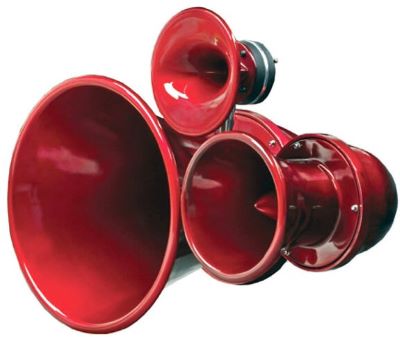
Hi mga2009 -
I don't see why not? Really the key is to match to the woofers directivity. Because waveguides of this size will easily control directivity down low enough to match a 12" they can simply be crossed higher to match an 8" woofer.
The only downside is that the 8" will be omnidirectional to a higher frequency which is a big part of why the 15" based two way is the best compromise where one has a large enough waveguide that extends CD lower.
Hi sheeple, thank you and me too!

but I personally genuinely hate the way (sticking out) it looks
I have to agree, I've always thought (until Ath4) the large free standing horn systems were more for looks rather than performance and was put off by that look.
These do sound good, tho the round over, I'm sure, is completely inadequate...
Hi mga2009 -
I'd like to build a replica of my KG5.5's using either a pair of 10" or 12" Dayton Designer Series. These seem to strike a good price/performance efficiency/extension balance.What woofer are you planning to use with the ST260?
Any chance one could use a 8" and still have a good match between the woofer and the waveguide at the crossover point?
I don't see why not? Really the key is to match to the woofers directivity. Because waveguides of this size will easily control directivity down low enough to match a 12" they can simply be crossed higher to match an 8" woofer.
The only downside is that the 8" will be omnidirectional to a higher frequency which is a big part of why the 15" based two way is the best compromise where one has a large enough waveguide that extends CD lower.
I am very interested to see the baffled response.
Hi sheeple, thank you and me too!

Attachments
Last edited:
I know how you feel. The technical part is easy, this is the really difficult stuff[...] I managed to get maybe, just maybe an acceptable level of wiggling with a waveguided direct radiator (dome tweeter) and a rather conventional-looking chamfered/rounded baffle, but still jealous about the cleanness of the directivity with the rolling back and having a bit of grudge against my phobia.
I stumbled upon this guy on YouTube, he does a lot of wave simulations in different environments.
Could be interesting for waveguides as well:
Nils Berglund - YouTube
Could be interesting for waveguides as well:
Nils Berglund - YouTube
BTW, there was a small listening session recently -
I can't tell you more because I wasn't there, but BV was
I only know the Sandhorns rated quite high.
man, must be hard to compare though. I bet the JBL's arn't close to what we consider neutral at all these days
I only know the Sandhorns rated quite high.
Just looking at them and I could guess the results.
Although I might toe-in the waveguides more, depending on seating location.
- Home
- Loudspeakers
- Multi-Way
- Acoustic Horn Design – The Easy Way (Ath4)
